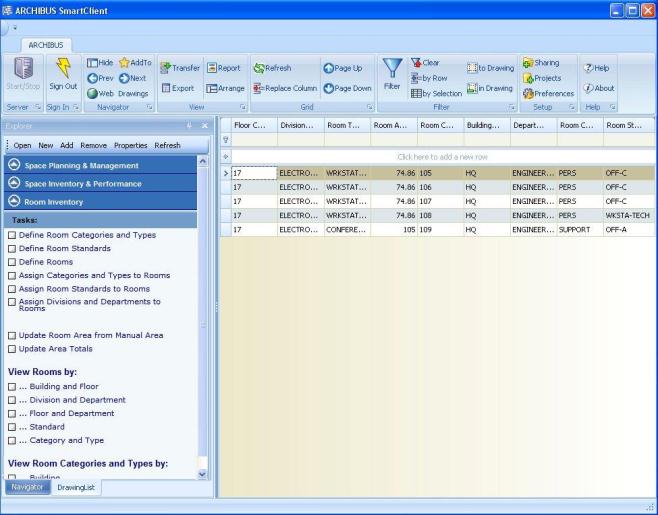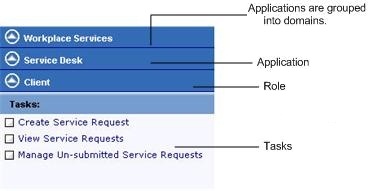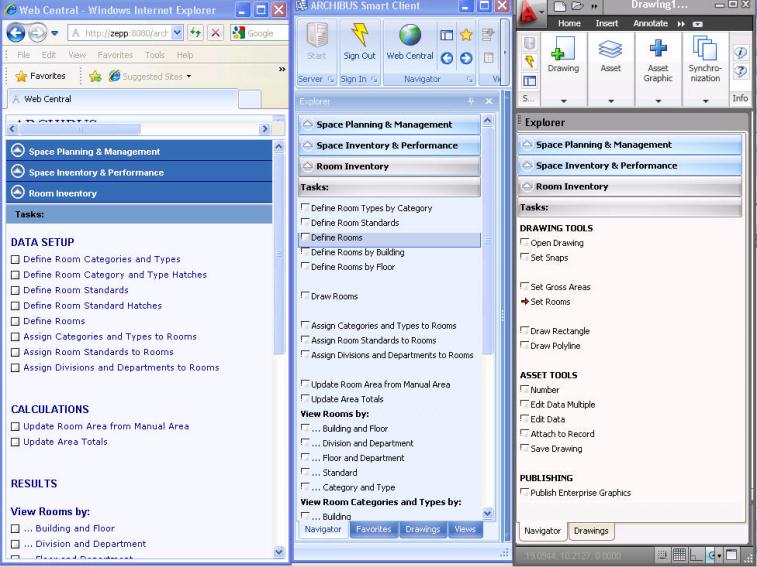
ARCHIBUS has several components:
Many organizations want to broadly share—both internally and externally—their facilities data by making it available through the Internet or a corporate Intranet. ARCHIBUS Web Central (Web Central) provides live enterprise access to facilities data and enables you to easily maintain and distribute facilities information across your entire enterprise.
With Web Central, everyone in your company—from the occasional user reporting a maintenance issue, to the department manager checking chargeback amounts, to the space planner allocating space—can access and update facilities data using the familiar interface of a Web browser.
ARCHIBUS Web Central uses role-based security so that when users log on, they access only the tasks and information relevant to their specific roles within the organization. For example, craftspersons see only the tasks and data for maintenance work at their site; department managers can edit only the rooms assigned to their departments and can examine space chargeback only for these departments.

The Smart Client is a rich-client, .Net Windows application that works from the same Web application server that Web Central does, and operates using the same set of Web Services as Web Central. However, for most operations it uses even less bandwidth than Web Central operating in a Web browser because it transfers only the data, and not the interface, from the server to the client.
ARCHIBUS Smart Client is typically used by back-office personnel for bulk data entry, data transfer, and importing and exporting data from other systems. It also provides tasks for robust data analysis.
Facility managers and others at your site whose main task is managing the facility and infrastructure will find that ARCHIBUS Smart Client provides them with a central location from which they can work without having to switch applications. In addition to accessing grid views for bulk data management, they can also launch their CAD program from Smart Client or display any Web Central view or application feature within the browser window embedded in Smart Client.

As part of your project data, you may want to include CAD (Computer-Aided Drawing) drawings. For example, you can have CAD drawings of each of your buildings' floors, and these floor plan drawings can include such information as the floor's boundary and the boundaries of the rooms, suites, and vertical penetration areas located on the floor. You can also include other information, such as depictions of your furniture, equipment, and telecom devices. These depictions in CAD drawings can be linked to records in the ARCHIBUS database so that the item is documented both graphically and alphanumerically; such items are known as asset symbols.
In order to link items in your CAD drawings to the ARCHIBUS database you need to work with the ARCHIBUS drawing tools: the Smart Client Extension for AutoCAD, or the Smart Client DWG Editor. These programs invisibly reside on top of the full AutoCAD and AutoCAD OEM programs and use Web Services to sign into and connect to the ARCHIBUS server application. The programs use reactors to extend native AutoCAD commands, and also provide their own set of commands for linking drawing items to database records (as shown on the ARCHIBUS ribbon in the below image).

Applications focus on a particular facet of facilities management, such as preventive maintenance, room inventory, personnel inventory, equipment inventory, move management, space chargeback, capital budgeting, condition assessment, and emergency preparedness. The applications are closely connected in that they access the same database. Data you develop with one application can be accessed and reused with another.
An application can divide its major issues into a series of processes, and provides tasks for accomplishing this process; or, an application can be role-based and provide all the tasks required for a certain role. An application includes tables for recording data in a database, a set of reports and graphic analyses, routines that run calculations and manipulate data, and specialized tabbed dialogs that walk you through a task.
To present and organize the ARCHIBUS applications and their processes, roles, and tasks, ARCHIBUS programs use the Process Navigator interface. Users drill down through the Process Navigator to access applications, processes or roles, and the component tasks. For each user, the Process Navigator can be customized to show only the applications, processes, roles,and tasks required for the user's work.

All three ARCHIBUS programs -- Web Central, Smart Client, and the Smart Client CAD programs -- use the Process Navigator interface to organize an application's tasks. While some users may work with an application only in Web Central, CAD specialists and those performing bulk data entry will work through the Process Navigators of the Smart Client or the Smart Client Extensions for CAD programs.
Note: Whereas the above image of the Service Desk application shows that Service Desk is organized into roles, the Space Inventory & Performance application (pictured below) is organized into processes, such as the Room Inventory process.
